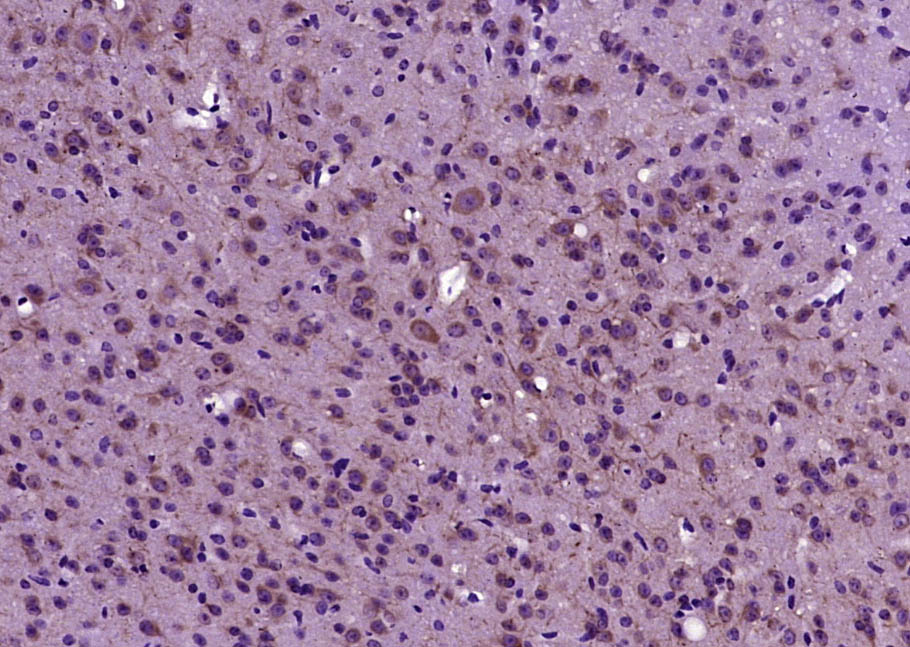
Rabbit Anti-DMPK antibody
Dystrophia myotonica protein kinase; DM 1; DM; DM kinase; DM protein kinase; DM-kinase; DM1; DM1 protein kinase; DM1PK; DMK; DMPK; DMPK_HUMAN; Dystrophia myotonica 1; Dystrophia myotonica protein kinase; MDPK; MT PK; MT-PK; Myotonic dystrophy associated p
View History [Clear]
Details
Product Name DMPK Chinese Name 肌强直性营养不良蛋白激酶抗体 Alias Dystrophia myotonica protein kinase; DM 1; DM; DM kinase; DM protein kinase; DM-kinase; DM1; DM1 protein kinase; DM1PK; DMK; DMPK; DMPK_HUMAN; Dystrophia myotonica 1; Dystrophia myotonica protein kinase; MDPK; MT PK; MT-PK; Myotonic dystrophy associated protein kinase; Myotonic dystrophy protein kinase; Myotonin protein kinase A; Myotonin protein kinase; Myotonin-protein kinase; Thymopoietin homolog. Research Area Cardiovascular Neurobiology Signal transduction Kinases and Phosphatases Immunogen Species Rabbit Clonality Polyclonal React Species Mouse, (predicted: Human, Rat, Dog, Pig, Cow, Sheep, ) Applications ELISA=1:5000-10000 IHC-P=1:100-500 IHC-F=1:100-500 ICC=1:100-500 IF=1:100-500 (Paraffin sections need antigen repair)
not yet tested in other applications.
optimal dilutions/concentrations should be determined by the end user.Theoretical molecular weight 69kDa Cellular localization The nucleus cytoplasmic The cell membrane Form Liquid Concentration 1mg/ml immunogen KLH conjugated synthetic peptide derived from human DMPK: 51-120/629 Lsotype IgG Purification affinity purified by Protein A Buffer Solution 0.01M TBS(pH7.4) with 1% BSA, 0.03% Proclin300 and 50% Glycerol. Storage Shipped at 4℃. Store at -20 °C for one year. Avoid repeated freeze/thaw cycles. Attention This product as supplied is intended for research use only, not for use in human, therapeutic or diagnostic applications. PubMed PubMed Product Detail Myotonic dystrophy protein kinase is a multi-domain protein kinase found in muscle that is activated in response to G protein second messengers and proteolysis (1). DMPK is implicated in myotonic muscular dystrophy (DM), an autosomal dominant-inherited disorder that predominately affects skeletal and cardiac muscle and causes defects in cardiac conduction (2,3). DM arises through expansion of CTG repeats in the 3’-UTR of the DMPK gene (4). Mutant DMPK transcripts with an extended region of CUG repeats are retained in the nucleus (5). These transcripts also influence the expression of the DM locus-associated homeodomain protein (DMAHP)/SIX5, to mediate in part the DM phenotype (6). Other substrates for DMPK include myogenin, L-type calcium channels, and Phospholemman (PLM) (1).
Function:
Non-receptor serine/threonine protein kinase which isnecessary for the maintenance of skeletal muscle structure andfunction. May play a role in myocyte differentiation and survivalby regulating the integrity of the nuclear envelope and theexpression of muscle-specific genes. May also phosphorylatePPP1R12A and inhibit the myosin phosphatase activity to regulatemyosin phosphorylation. Also critical to the modulation of cardiaccontractility and to the maintenance of proper cardiac conductionactivity probably through the regulation of cellular calciumhomeostasis. Phosphorylates PLN, a regulator of calcium pumps andmay regulate sarcoplasmic reticulum calcium uptake in myocytes. Mayalso phosphorylate FXYD1/PLM which is able to induce chloridecurrents. May also play a role in synaptic plasticity.
Subunit:
Homodimer; homodimerization stimulates the kinaseactivity. Interacts with HSPB2; may enhance DMPK kinase activity.Interacts with PLN; phosphorylates PLN. May interact with RAC1; mayregulate DMPK kinase activity. Interacts with LMNA; may regulatenuclear envelope stability.
Subcellular Location:
Endoplasmic reticulum membrane; Single-passtype IV membrane protein; Cytoplasmic side (By similarity). Nucleusouter membrane; Single-pass type IV membrane protein; Cytoplasmicside (Probable). Mitochondrion outer membrane; Single-pass type IVmembrane protein (Probable). Sarcoplasmic reticulum membrane (Bysimilarity). Cell membrane (By similarity). Cytoplasm, cytosol (Bysimilarity). Note=Localizes to sarcoplasmic reticulum membranes ofcardiomyocytes (By similarity).
Isoform 1: Mitochondrion membrane.
Isoform 3: Mitochondrion membrane.
Tissue Specificity:
Most isoforms are expressed in many tissues including heart, skeletal muscle, liver and brain, except for isoform 2 which is only found in the heart and skeletal muscle, and isoform 14 which is only found in the brain, with high levels in the striatum, cerebellar cortex and pons.
Post-translational modifications:
Phosphorylated. Autophosphorylates. Phosphorylation by RAF1may result in activation of DMPK.
Proteolytic processing of the C-terminus may remove thetransmembrane domain and release the kinase from membranesstimulating its activity.
DISEASE:
Defects in DMPK are the cause of dystrophia myotonica type 1 (DM1) [MIM:160900]; also known as Steinert disease. A muscular disorder characterized by myotonia, muscle wasting in the distal extremities, cataract, hypogonadism, defective endocrine functions, male baldness and cardiac arrhythmias. Note=The causative mutation is a CTG expansion in the 3'-UTR of the DMPK gene. A length exceeding 50 CTG repeats is pathogenic, while normal individuals have 5 to 37 repeats. Intermediate alleles with 35-49 triplets are not disease-causing but show instability in intergenerational transmissions. Disease severity varies with the number of repeats: mildly affected persons have 50 to 150 repeats, patients with classic DM have 100 to 1,000 repeats, and those with congenital onset can have more than 2,000 repeats.
Similarity:
Belongs to the protein kinase superfamily. AGC Ser/Thr protein kinase family. DMPK subfamily.
Contains 1 AGC-kinase C-terminal domain.
Contains 1 protein kinase domain.
SWISS:
Q09013
Gene ID:
1760
Database links:Entrez Gene: 1760 Human
Entrez Gene: 13400 Mouse
Omim: 605377 Human
SwissProt: Q09013 Human
SwissProt: P54265 Mouse
Unigene: 631596 Human
Unigene: 6529 Mouse
Unigene: 130535 Rat
Product Picture
Bought notes(bought amounts latest0)
No one bought this product
User Comment(Total0User Comment Num)
- No comment



 +86 571 56623320
+86 571 56623320
 +86 18668110335
+86 18668110335

